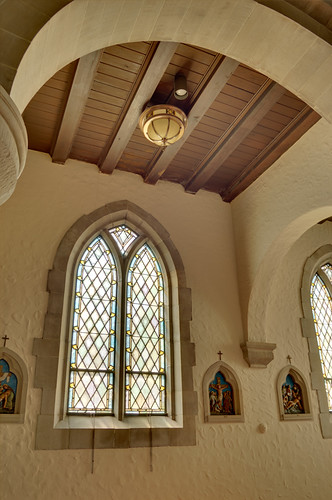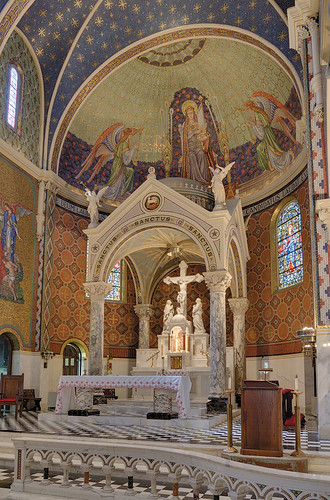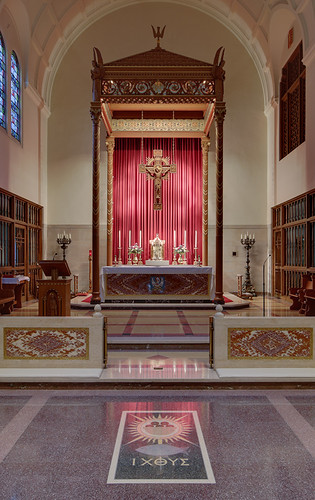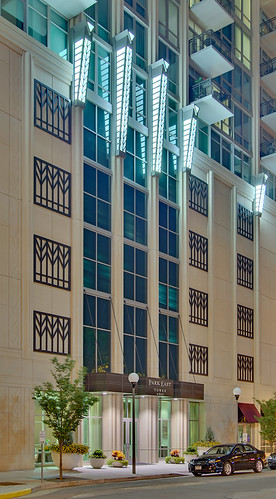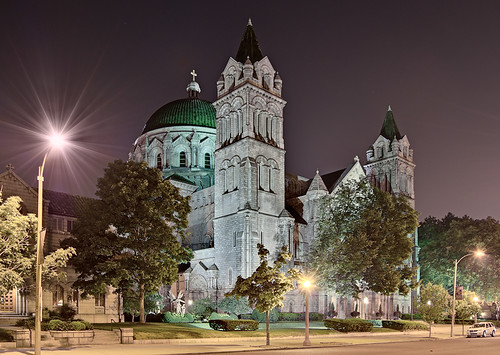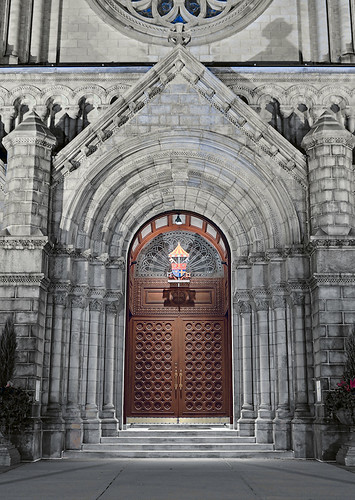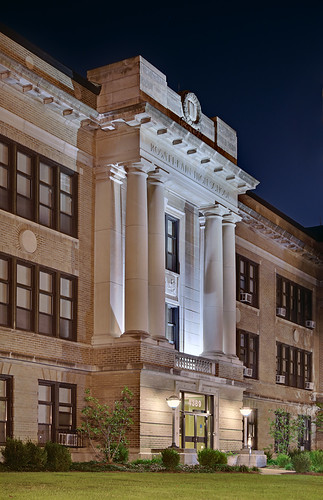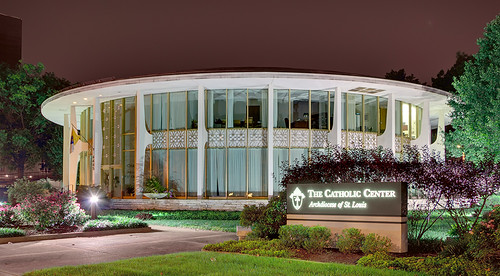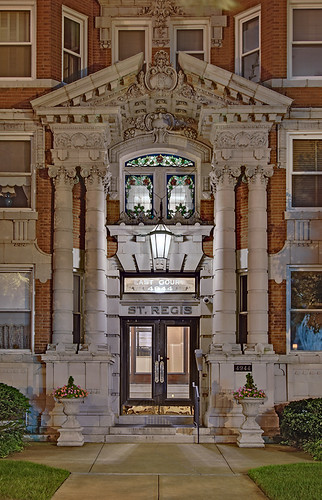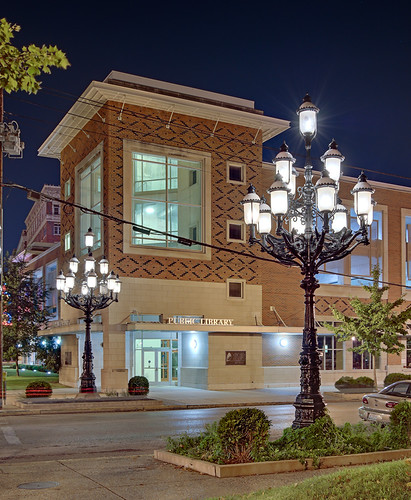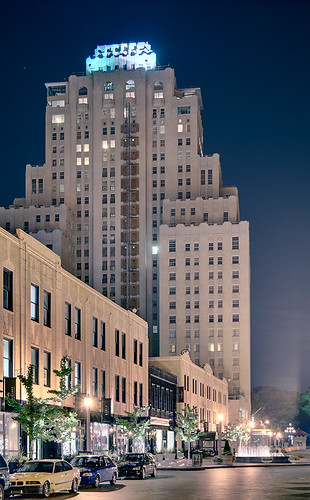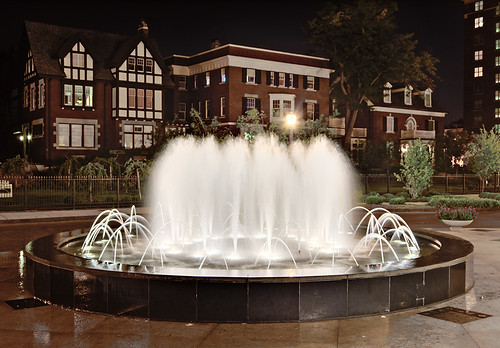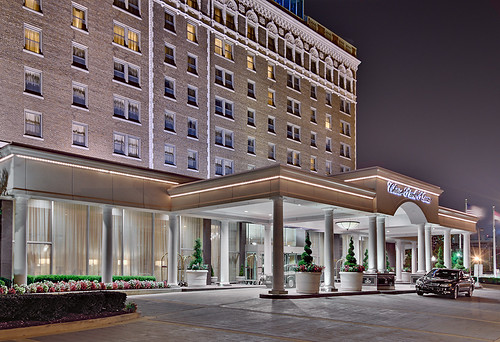...when tempted against purity, would study Hebrew.
He became one of the greatest Hebrew scholars.
Tuesday, September 30, 2008
Monday, September 29, 2008
Photo of Saint Michael the Archangel Church, in Shrewsbury, Missouri
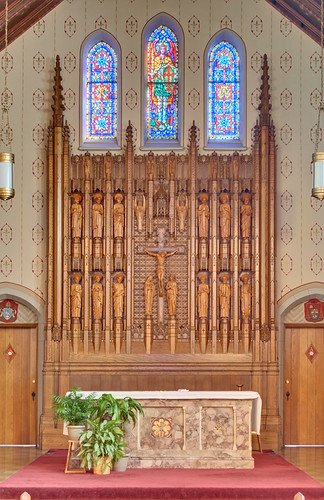
For Michaelmas, here is a photo taken recently at Saint Michael the Archangel Church, in the suburban Saint Louis County city of Shrewsbury, Missouri. The central stained glass window depicts Michael.
Saturday, September 27, 2008
Friday, September 26, 2008
The Political Life of American Catholics, Part II
IMAGINE A BEACH: sunny, pleasant, and popular, with vacationers playing in the surf and strolling up and down the sand.
Now imagine that you are a shopkeeper: you own a small stand, not much more than a kiosk really, where you sell suntan lotion, snacks, drinks, and so forth to these beach vacationers. Furthermore, since it is rather small, you can easily move it wherever you please along the sandy shore.
Imagine further that you have a competitor on the beach, who sells the same goods as you do, and who also has a small, portable stand. Vacationers walk to the closest stand to make their purchase: either yours or your competitor's.
Your problem: what position along the beach is best for business? Please keep in mind that your competitor has the identical problem.
The answer: both stands will most likely end up right next to each other, right in the middle of the beach. If you move your stand further along the beach, your competitor will follow you, capturing a greater share of the middle.
This is of course a political analogy. Politicians position themselves in the middle because that is where the votes are.
Some vacationers, who prefer the left or right ends of the beach, may resent having to walk so far to get to the shops. AS LONG AS they make the long walk, the shopkeepers could hardly care. Likewise in politics, the 'kook fringe' of the left and right is of little consequence to politicians as long as they will vote. The voting takes place in the middle.
Now imagine that you are a shopkeeper: you own a small stand, not much more than a kiosk really, where you sell suntan lotion, snacks, drinks, and so forth to these beach vacationers. Furthermore, since it is rather small, you can easily move it wherever you please along the sandy shore.
Imagine further that you have a competitor on the beach, who sells the same goods as you do, and who also has a small, portable stand. Vacationers walk to the closest stand to make their purchase: either yours or your competitor's.
Your problem: what position along the beach is best for business? Please keep in mind that your competitor has the identical problem.
The answer: both stands will most likely end up right next to each other, right in the middle of the beach. If you move your stand further along the beach, your competitor will follow you, capturing a greater share of the middle.
This is of course a political analogy. Politicians position themselves in the middle because that is where the votes are.
Some vacationers, who prefer the left or right ends of the beach, may resent having to walk so far to get to the shops. AS LONG AS they make the long walk, the shopkeepers could hardly care. Likewise in politics, the 'kook fringe' of the left and right is of little consequence to politicians as long as they will vote. The voting takes place in the middle.
We could say that American Catholics used to live along one section of the beach, as once they lived around their parish churches. They were loyal to their party and politicians, and in return, the politicians were loyal to them. Shopkeepers will move to where they can sell their goods, and keeping a return customer is far easier than finding a new one.
Everything changed after the worldwide revolutions of the Summer of Hate in 1968, with Satan unbound: old loyalties dissolved, heresy's inferno devastated our churches, and new policies were imposed against the will of the people. It was as if an angry mob picked up one of the kiosks and forced it to relocate to an unprofitable section of the beach.
A political system imposed against the will — and most critically beyond the control — of the electorate is likely to cause anger, resentment, and apathy, none of which are virtues. These disenfranchised are then placated with 'bread and circuses', leading society into sharp decline.
Catholics and others of good will cannot hope to change society through the political process, but must rather pray and work for the conversion of hearts. Obviously, we must be active in politics so as to protect our rights at a minimum, but we must not copy the strategies of the Culture of Death, which imposes policy by force. In other words, we have to restore our center, and the politicians will want to follow.
Thursday, September 25, 2008
Photo of Our Lady of Lourdes Church, in University City, Missouri
Tuesday, September 23, 2008
The Political Life of American Catholics
AMERICAN CATHOLICS generally vote as if they are either Freemasons or Socialists, but certainly not as Catholics. This no doubt is due to our cultural milieu, especially as conditioned by the schools and media, as well as poor catechesis and lukewarm faith (as mine so often is).
Just reading blogs and editorial pages will demonstrate this fact: rarely will commentators hold to the general Catholic view. Politically conservative Catholics will state that a living family wage is impossible since wages ought to conform to market rates. Politically liberal Catholics will state that they will not oppose abortion unless society addresses other social problems. Rather, a living family wage ought to be the center of the organization of the economy, and the right to life is at the top of the hierarchy of values.
Any Catholic who agrees with the typical platform of either the Republican or Democratic Party is objectively a heretic. Fortunately for us, although the precepts of the Church's Social Doctrine is grave matter — that is, if you fail to follow them you go to Hell — the Church recognizes that the difficulty of gaining adequate knowledge of the matter can mitigate the severity of our guilt. However, non-Catholics are not completely off the hook: unlike matters of Church discipline like the observance of days of penance and fasting, the Church proposes that this doctrine is a part of the Natural Law, and so is binding in conscience on all persons.
Evidence that the Social Doctrine is a part of the Natural Law is shown by its observance in many stable cultures all over the world and throughout history. Only when we get to the Renaissance, Enlightenment, and French Revolution do we see a clean break from the ideals of the past, as well as the increasingly violent ways of solving social problems. Forcing people out of their jobs is good for the economy, some say. Killing people is the best way to achieve good health care, say others.
Both political parties seem completely dedicated to the principle of competition: for the Republicans, it is competition among businesses; for the Democrats, it is competition between social classes. Both parties are dedicated to encouraging competition between nations, although in different ways. The principle of competition, as the primary mechanism for the advancement of society, is a heresy and belies a materialistic worldview, although it does have a minor role to play. Rather, the social doctrine is more spiritualistic and emphases cooperation and agreement in all levels of society, including public and private institutions. Now both parties no doubt would like cooperation, as long as their opposition is silenced. And so shamefully, both parties promote ever greater competition in the spheres of their interest, causing ever greater chaos in society.
I would suggest reading the Compendium of the Social Doctrine of the Church. There is much in here to delight both conservatives and liberals of good will! However, it may outrage those who seek great wealth or big government, or those who seek to do their own will, in the spirit of non serviam. Catholics ought to form their conscience on the Social Doctrine of the Church, this being an integral part of her preaching the Gospel for the purpose of "helping man on the path to salvation".
Monday, September 22, 2008
Farewell for Fr. Lenhardt
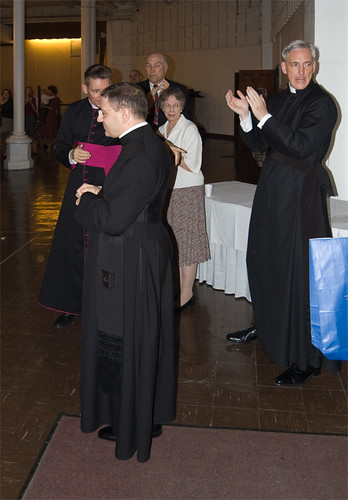
Applause for Fr. Karl Lenhardt, outgoing rector of Saint Francis de Sales Oratory, after his final public Mass yesterday.
Msgr. Schmitz, Provincial for the Institute of Christ the King Sovereign Priest, is to the left, and Father Wiener, our new rector, is to the right.
Friday, September 19, 2008
Pope Benedict's Visit to Paris
Click here for photos and commentary from Andrew Cusack.

This flag is the French tricoloeur superimposed with the Sacred Heart of Vendée, used by Catholic traditionalists who accept the Republic.
It was the French thinker Charles Maurras — not himself a Catholic until the very end of his life — who conceived of the notion that that (since the Revolution) there was not one France but two: le pays réel and le pays legal; The real France, Catholic and true, versus the official France, irreligious and contrived.

This flag is the French tricoloeur superimposed with the Sacred Heart of Vendée, used by Catholic traditionalists who accept the Republic.
Thursday, September 18, 2008
Audio Lectures
FOR YOUR EDIFICATION and enjoyment, you may want to listen to the audio lecture series, The Mystery of Israel and the Church, by Professor Larwrence Feingold, on the website of the Association of Hebrew Catholics. Included in the lectures is an overview of Old Testament Messianic prophesy and typology.
Prof. Feingold teaches pastoral theology in Saint Louis.
Tuesday, September 16, 2008
Photo of Saint Louis Riverfront
Monday, September 15, 2008
Late-Night "-isms"
HAVING HAD software problems yesterday, wasting about six hours, and a project deadline to meet today, I made the fateful decision to drink some coffee and finish my work, no matter how late (or early).
While waiting for a compute-intensive computer program to complete, I was considering the fact that most — or nearly all — traditional art and architectural styles, of every nation, continent, religion, and historical era are attractive and generally appealing. So much of the world is photogenic!
While waiting for a compute-intensive computer program to complete, I was considering the fact that most — or nearly all — traditional art and architectural styles, of every nation, continent, religion, and historical era are attractive and generally appealing. So much of the world is photogenic!
Widespread ugliness is a product of our modern age, partially due to the desire for efficiency (which while a virtue, is pretty low on the scale of virtues), and largely due to bad philosophy, which has trickled down through society from the academy to everyday life.
The ugliness of Modernism is well-known, especially in architecture and the fine arts: however, some contemporary industrial design is of extraordinary quality and beauty, which perhaps I'll consider some other day.
There is a formal philosophy called "Traditionalism" which basically states that the old ways are the best ways. This, however, is a heresy, and is ultimately based on cultural relativism and social Darwinism, as well as denying various virtues (such as Art and Science, in the Thomistic sense). This ought to be contrasted with the better-known heresy of Modernism (and its contemporary variants) which states that new ways are the best ways, which is also based on relativism, social Darwinism and also denies virtues.
Alternatively, there can be a Catholic theology of art. All that is true, good, and beautiful, ultimately derives these transcendental attributes from God. Insofar as a culture — any culture — conforms to what is true and good, then beauty ought to follow. Where truth and goodness are denied, ugliness most certainly follows.
Friday, September 12, 2008
Upcoming Event at the Oratory
A NEWSLETTER from Saint Francis de Sales Oratory:
Dear Faithful and Friends of St. Francis de Sales Oratory,
This Sunday, September 14, feast day of the Exaltation of the Holy Cross marks the first anniversary of the Motu Proprio Summorum Pontificum becoming effective. This anniversary fills us with great joy and gratitude to Divine Providence and to our Holy Father. The publication of the Motu Proprio has strongly contributed to the growth and development of our Oratory.
At St. Francis de Sales Oratory we are very blessed that through the great pastoral wisdom of His Grace, The Most Rev. Raymond L. Burke, Prefect of the Supreme Tribunal of the Apostolic Signatura and Archbishop Emeritus of St. Louis, the principles and intentions of the Motu Proprio had already been implemented since the foundation of our Oratory. Over the last three years the Oratory has developed as a spiritual center for the whole Archdiocese of St. Louis. The Oratory is the church with the most confessions in the whole archdiocese and many people from all over this archdiocese and beyond come for confessions. Innumerable priests and seminarians from various dioceses visit the Oratory and attend Masses. The development of the Sacred Music at the Oratory sets standards for the celebration of the Extraordinary Form of the Roman Rite. I thank everyone who generously contributes to these and to all the activities at the Oratory.
On the occasion of this first anniversary of the Motu Proprio Summorum Pontificum our Institute has been invited to celebrate a Solemn High Mass at the Shrine of the Most Blessed Sacrament in Hanceville, Alabama. I am honored to be the celebrant of this Mass. The Mass will be broadcasted by EWTN: Sun 9/14/08 7:00 AM and Mon 9/15/08 11:00 PM Encore.
It is with great joy that I have the occasion to welcome my successor as Rector of St. Francis de Sales Oratory, the Rev. Father Michael K. Wiener. His arrival is an expression of great continuity in the life of our Oratory. We invite all of you to my farewell Mass at the Oratory and to the installation of Fr. Wiener as Rector next Sunday, September 21, 2008 at 10:00 am. A reception will follow in the church hall.
With my best regards and the assurance of my prayers in your intentions
Yours devotedly in Christ the King
Fr. Karl W. Lenhardt
Episcopal Delegate, Rector, Vice Provincial
"INSTITUTE TO CELEBRATE LIVE TELEVISED MASS"
FROM THE WEBSITE of the Institute of Christ the King, Sovereign Priest:
On Sunday, September 14th, members of the Institute of Christ the King Sovereign Priest will celebrate a Solemn High Mass at Our Lady of the Angels Monastery of the Poor Clares of Perpetual Adoration in Hanceville, Alabama. The conventual Mass will be broadcast live by EWTN, the Global Catholic Network, to a worldwide audience of 140 million homes, through TV, radio, and live streaming video online.Watch Fr. Karl Lenhardt of Saint Francis de Sales Oratory on TV!
September 14th marks the first anniversary of the implementation of Pope Benedict XVI's motu proprio "Summorum Pontificum" [PDF]. The Solemn High Mass will be in commemoration of, and thanksgiving for, this pivotal document of His Holiness, which confirms that the Latin Rite in its ancient form as presented in the 1962 liturgical books of the Roman Catholic Church was never abrogated and is available to all priests and all faithful who desire it.
The live broadcast on September 14 from Our Lady of the Angels Monastery will take place at 8:00 AM Eastern Time USA, 14:00 Central European Time, 12:00 UTC. There will be a rebroadcast at 11:00 PM Central Time, 9:00 PM Pacific Time.
Holy Hour for New Religious Order
BISHOP ROBERT HERMANN will hold a Holy Hour for Rosalind Moss' new religious order, Daughters of Mary, Mother of Israel's Hope, at Saint George Parish in Affton (Gardenville), Missouri, on Sunday, September 14th at 5 p.m. A reception and tour of the Sisters' convent follows the Holy Hour.
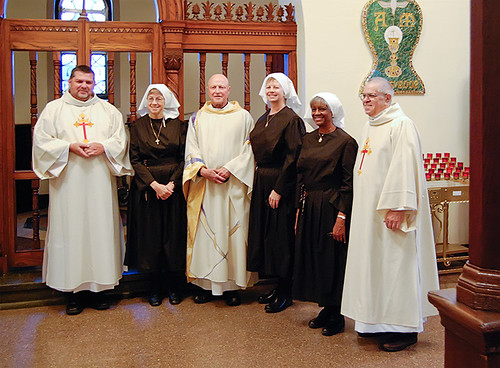
The ladies in their new postulant's habits. Full canonical establishment of the religious order will have to wait until Saint Louis gets a new Archbishop, and then they will be invested in full habits.

The convent chapel. The convent was built in the early 1950s, and is in the Modern style. I was pleased to see that the building was made of identical materials and similar architecture as is my own house nearby. While plain, the construction quality is superb. There is also plenty of wall space for artwork. Maybe the Sisters would like some photos of area churches?
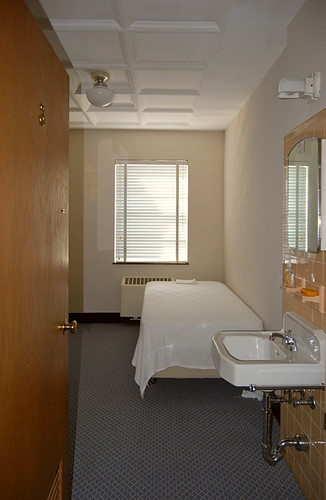
One of the cloister's cells.
Affton, Missouri 63123

The ladies in their new postulant's habits. Full canonical establishment of the religious order will have to wait until Saint Louis gets a new Archbishop, and then they will be invested in full habits.

The convent chapel. The convent was built in the early 1950s, and is in the Modern style. I was pleased to see that the building was made of identical materials and similar architecture as is my own house nearby. While plain, the construction quality is superb. There is also plenty of wall space for artwork. Maybe the Sisters would like some photos of area churches?

One of the cloister's cells.
Address:
4974 Heege RoadAffton, Missouri 63123
Thursday, September 11, 2008
VICTORY
SEPTEMBER 11th, 1683, the forces of Austria, Germany, and Poland, under the command of King John Sobieski of Poland, defeated the army of the Ottoman Turk at the gates of Vienna, finally reversing the expansion of Islam, which in a thousand years had captured by force two thirds of Christendom.
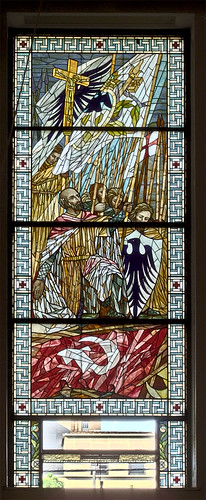
King John Sobieski, depicted on a stained glass window at the Cathedral of the Immaculate Conception in Springfield, Illinois.
Explosives were set under the city walls, and the fuse was lit; the fuse was extinguished at the last moment as the Polish heavy infantry attacked; and one of the largest calvary charges in history, led by Sobieski, finally defeated and scattered the Ottoman troops.
The Holy League, supported by Pope Innocent XI, arrived at the besieged Vienna just as the Ottomans were prepared to breach the city walls and do battle in the streets against the starving defenders.

King John Sobieski, depicted on a stained glass window at the Cathedral of the Immaculate Conception in Springfield, Illinois.
Explosives were set under the city walls, and the fuse was lit; the fuse was extinguished at the last moment as the Polish heavy infantry attacked; and one of the largest calvary charges in history, led by Sobieski, finally defeated and scattered the Ottoman troops.
This battle was not in the Holy League's personal interest, for in fact their countries were left practically undefended and in consequence their lands shamefully suffered attacks from their Christian neighbors. Rather, the Holy League fought and sacrificed for Christendom herself, and halted the advance of Islam into Europe for centuries.
Sadly, Christendom hardly exists anymore, and the barbarians have now been invited within the gates of Vienna. The European elites hardly care, for perhaps they think that they can subvert Islam just as easily as they ruined Christianity. But they misjudge their skills in cultural genocide as much as they underestimate the determination of Islam. Drugs, entertainment and sex keep the European masses unaware of the fact that they live under totalitarian rule, but Muslim minds remain keen, and they watch and wait in anticipation for the time to resume their conquest, halted over three centuries ago.
Monday, September 08, 2008
Photos of the Central West End Neighborhood of Saint Louis, Missouri
THE CENTRAL WEST END is a neighborhood of the City of Saint Louis, located between Midtown to the east, and Forest Park to the west and south. It is the "central" part of the western end of town.
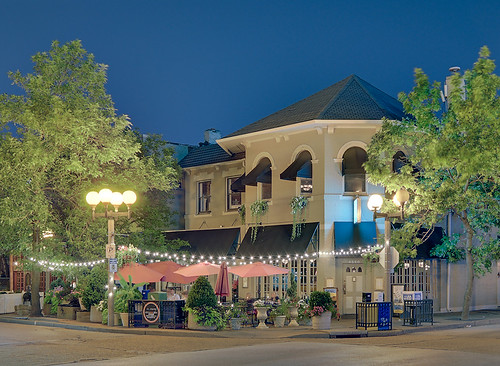
Above is an outdoor café in the neighborhood. Outdoor fine dining in Saint Louis did not exist until the 1970s, although beer gardens have existed since the 19th century. These were opened by those who longed for the culinary culture of Europe, even though our hot, humid summers and cold winters militate against this imported idea.
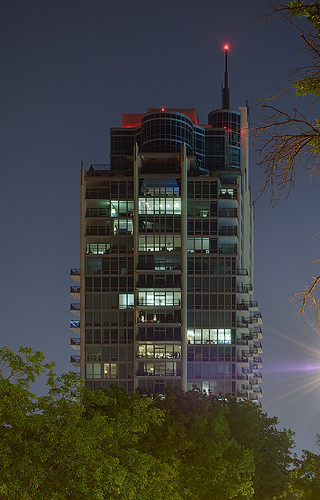

This is one of the most photogenic neighborhoods of the City, and probably one of the wealthiest, although wealth and charm are loosely correlated: consider the attractive yet modest Hill and Soulard neighborhoods, and the middle-income and beautiful Saint Louis Hills area with some of the ugly-but-wealthy new suburbs located far to the west of this area.
Above is an outdoor café in the neighborhood. Outdoor fine dining in Saint Louis did not exist until the 1970s, although beer gardens have existed since the 19th century. These were opened by those who longed for the culinary culture of Europe, even though our hot, humid summers and cold winters militate against this imported idea.

The Park East tower is newly built, and joins the neighborhood's many other high-rise apartment buildings constructed over the past 100 years. And like many of the major historic construction projects in the area, it was for the developer unfortunately completed after the burst of a bubble in real estate prices.
Door of the Park East Tower.
The Central West End tends to be home to urban hipsters, transplanted folks from the East and West coasts, members of old-line Catholic families, and very many medical students and workers. Originally developed in the 1880s, construction of most homes dates from the 1890s to 1910s, with waves of demolition and redevelopment taking place during the booms in the 1920s, 1960s, and the past few years. Much of the northern part of the area consists of private, gated streets, while the southern portion of the area has medical establishments and industry.
The western expansion the city includes the westward motion of the wealthy along the 'central corridor' of the area, which roughly follows the route of Interstate-64/Highway 40 westward into Saint Louis and Saint Charles counties. Mansions along Washington Avenue downtown were destroyed for industry with the occupants moving ever westward, into Midtown, the Central West End, the Debaliviere neighborhood, University City, Clayton, Ladue, Frontenac, Chesterfield, Wildwood, and now Saint Charles County across the Missouri River. Lower income is generally found to the north and south of this axis.
Rootlessness tends to be a problem with our contemporary culture, which always seeks the latest trends, including trends in architectural style and neighborhoods. With globalization, entire countries are ranked according to trendiness, and they are flooded with transient populations who may care little for local culture. The ancient Greco-Roman Stoic idea of the cosmopolis or 'universal city', where all of society is one, is well reflected by this very cosmopolitan neighborhood, which sometimes has less in common with Saint Louis than it has with the elite thinking of the rest of the Western world.
Catholic thinking does agree with the concept of the cosmopolis, but in spiritual and not material matters, and argues instead for stability in local life. Perhaps this is why historic Catholic neighborhoods here tend to be very stable and strong, despite wealth or its lack. When the trendy moved out of the Central West End in the 1960s, the Catholics stayed, and kept the neighborhood afloat until it was restored. Place does matter, and the affection you have for a neighborhood, just because it is familiar and your own, and not because of what it can do for you, is what ultimately keeps neighborhoods alive.
The Park Royal on Lindell Boulevard, dating from 1929; to its right is a new building, completed in 2007.
Many properties in the Central West End, especially on the private streets, have extensive restrictive covenants on their titles.
The concept of restrictive covenants is almost un-American. The concept that a restriction on the use of a property runs with the land and is privately created and enforced, is antithetical to the ideal of unrestricted free markets and to the social ideal that all restrictions and uses come from government. This concept is truly not American, but rather is handed down to us from England, where the law ultimately developed in the Medieval courts of equity run by the Catholic bishops. One could have predicted that problems would have occurred when this concept is implemented by a nation like the United States, which has a poor conception or outright rejection of the Natural Law.
But restrictive covenants, used wisely, help keep a neighborhood stable against the arbitrary plans of a wealthy property developer or the tyranny of government; in short, they keep power and influence very local; they can be abused, but only if those who make and enforce the covenant lack virtue.
There is only one Catholic church in the neighborhood, but that church happens to be the Cathedral Basilica of Saint Louis, which sees strong support from families who have lived in the neighborhood for generations.
Nearby parishes include Saint Francis Xavier to the east, and Saint Roch to the west.
Saint Nicholas Greek Orthodox Church is in the middle of the Central West End, and holds its popular annual festival during Labor Day weekend. Protestant denominations in the area seem weak or absent, with the bulk of the population being either Catholic or heathen.
Cathedral door, surmounted by a coat of arms indicating that this church has been named a minor basilica by the Pope.
Rosati-Kain High School is next door to the Cathedral, and is an Archdiocesan preparatory girl's school, founded in 1911. A boy's prep school, Saint Louis University High School, is run by the Jesuits and is located near the neighborhood.
Chancery offices of the Archdiocese are in this circular building, dating from 1961. This is an ecclesial building in the modern style, but of a lavish quality not seen since the Second Vatican Council.
Curiously, there is another similar round building just down the street, owned by the Automobile Association of Missouri. Click here for an informative and opinionated architectural photo tour of Lindell Boulevard. Construction data on these buildings can be found at Emporis.
A bit of Miami, Florida architecture is found at the Towne House, completed in 1965. But instead of a view of the ocean, this has a view of the Cathedral, which is best seen or photographed from one of these balconies.
Geographically, the Central West End is on level ground, making it eminently walkable and constructible, and was safely above the formerly flood-prone River des Peres, now underground, which used to flow to the immediate west in Forest Park.
The Pierre Chouteau Condominiums, dating from 1929, is named either after an early settler of Saint Louis, son of founder Pierre Laclède and half-brother of co-founder René Auguste Chouteau, or perhaps after his son, Pierre Jr., both of whom were prominent in the fur trade and the expansion of the nation westward.
Nowadays, political correctness has made the use of names of dead, white, European males — involved in colonization and the founding of the nation — almost unthinkable. While some of these these may have been scoundrels, the more recent trend in the City of naming things after living politicians and celebrities has proven even more embarrassing, for these too are often discovered to be scoundrels. This is one reason why Catholics name things after Saints - they have been already vetted for virtue.
Many contemporary names of things are now either boring or arbitrary, saying nothing true and specific. Several buildings on this street are named after their street address, which seems to be rather timid.
The St. Regis Apartments, constructed in 1903. This could be named after Saint John Regis, S.J. (1597 - 1640), or after the St. Regis Indian tribe of New York, or perhaps the St. Regis Hotel in New York City.
At the corner of Lindell Boulevard and Euclid Avenue, decorated with antique light stands, is the Schlafly branch of the Saint Louis Public Library.
Lindell Boulevard is named after Peter Lindell, a merchandiser and landowner in midtown. Euclid Avenue is named after a street of that name in Cleveland, Ohio, which in turn was named after the Greek geometer Euclid. The Schlaflys are a well-known Catholic family in the region, which includes Phyllis the political activist and Tom the brewer.
Maryland Plaza, with buildings from 1935 (foreground), recently redeveloped, and the high-rise Park Plaza Apartments, from 1931.
Stately former mansions on the north side of Maryland Avenue were for a while commercial offices and are now condominiums. Originally, a tall wall, now demolished, separated these homes from the street.
"White flight" due to racism is often cited as the reason for the decay of urban neighborhoods like this one, but the cause is more complicated. In the post-World War II era, the fear of nuclear war with the Soviet Union led to government policies to disperse dense urban populations into far-flung suburbs, and like many Cold War policies, it was implemented in an indirect manner. Simultaneously, other government policies led to the concentration of the urban poor into squalid high-rise developments in the urban core, along with the widespread destruction of their historic neighborhoods for the sake of "green space", leaving tremendous areas of the City empty to this day, lacking an economy, a tax base, as well as the widespread closure and destruction of large numbers of Catholic churches.
People were also driven out of the city. A new breed of politician, with the revolutionary fervor of 1968, told certain kinds of folks that they were no longer welcome, a trend which occurred nationally with the most destructive example being Detroit, Michigan. To this day, the City Fathers are intent on growing the childless urban hipster population, who will keep them in office and pay high taxes, while having little concern for traditional families. The public schools of Saint Louis seem to be intentionally awful, ensuring that conservative Republican middle-class Protestants with families will never live here.
For a while in the 1960s and 1970s, large homes such as these could have been purchased for a bargain, but now are again worth a fortune. Specifically it was high energy prices in the 1970s that caused these homes to lose tremendous value: utility bills could easily reach a thousand dollars per month. But it was the "urban pioneers" who rescued these buildings from destruction, using their own labor to renovate them and make them more efficient. Grand mansions, three stories tall, and once the locale of large families and lavish parties in their ballrooms, are now largely occupied by childless couples.
The buildings shown above face this fountain, which dances. Turn the camera around....
...and you see this alleyway, recently redeveloped, which leads to...
...another outdoor café, closed for the evening. Turning the camera around...
...shows another alleyway, with shops on the left and nice vegetation to the right.
The Chase-Park Plaza is a famous old hotel and apartment complex. The Chase was developed in 1922 by Chase Ullman, who named the hotel after himself. For a while, this was the greatest hotel in the City, then falling on hard times, but has since been renovated several times and has returned to vibrancy. The adjacent Park Plaza was seen in a previous photo.
A blurry outline of a car can be seen here due to the very long camera exposure time.
As the sky grows darker, the ugly sodium vapor lighting from the street makes color photography difficult. Here is the marquee of the Chase's theater, seen in glorious black and white.
Barnes-Jewish Hospital is the major employer in the neighborhood. The Center for Advanced Medicine dates from 2001, and is a part of Washington University's ever-growing medical campus.
Friday, September 05, 2008
Photo of Mother Duchesne's Bedroom
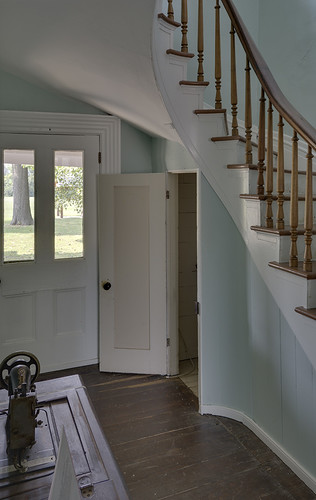
Saint Rose Philippine Duchesne's bedroom was a small closet under the stairs. Photo taken in the convent of Old Saint Ferdinand Shrine, in Florissant, Missouri.
A Note on the Photos
I AM HUMBLED by the reception of my photos here on Rome of the West. What started in response to a suggestion to show some of the then-about-to-be-closed churches in the Archdiocese, has become (according to one pastor) an "apostolate" of showing the beauty of the Catholic patrimony of art and architecture in my area. While I've always been pleased to spout off my own opinions, it is the photographs here that have proved popular, even though I'm usually dissatisfied with them.
I get many requests for the republication of my photos, and the work seen here can now be found on many church websites, weekly parish bulletins, an upcoming Illinois cathedral calendar, a diocesan directory, magazines, and an interesting project yet to be announced. I am happy to provide these images free of charge to dioceses, parishes, and religious orders and associations. Just send me an email (seen on the right side of my website) if you would like to use one of my photos.
The field of professional photography is undergoing financial difficulties lately and I understand the concern that any pro photographer may have regarding the fact that I give my work away for free. This service is in recognition of my grave duty as a Catholic to support the Church and by no means is meant to compete with commercial services.
I occasionally get requests to do commercial photography. These I am happy to fulfill as I am able, and I limit my work to the subject matter that I am comfortable with, namely, architecture and architectural interiors. My technique is directed towards displaying the detail, scale, proportion, and color inherent in an object in a way that is as naturalistic as the art allows, simultaneously considering how an object actually appears to the eye, as well as the desire to present the object as it would be seen under ideal circumstances. Please send me an email (displayed on the right) to discuss your project. My pricing is determined by time, expenses, and the final use of the photographs; camera equipment to be used is determined by the particular project.
I am also happy to provide large prints of selected photos. These are printed on fine art paper with fade-resistant pigments, mounted on gallery-quality archival matting for long life. A variety of framing is available. Photos available in color or richly toned black and white. Please send me an email to discuss specifics.
The Qurbono at Saint Raymond's Cathedral
THE DIVINE LITURGY, or Mass, of the Maronite Catholic Church is called the Qurbono and is offered at Saint Raymond's Maronite Cathedral, in Saint Louis, Missouri, seat of the Eparchy of Our Lady of Lebanon.
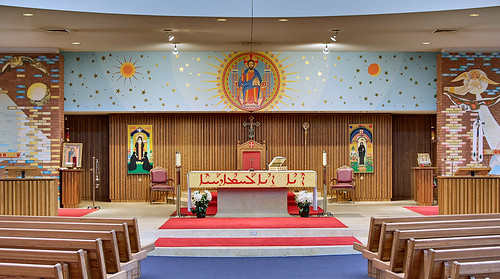

Photo taken after the Qurbono, offered by His Grace, Bishop Robert J. Shaheen. The church building dates from 1975.
Parts of this liturgy are some of the most ancient in the Church, with portions chanted and sung in Aramaic. While the chant modes used were unfamiliar to me, I was able to follow along, more or less, in prayer with the clergy, with the help of a fellow worshiper and the prayer book. Faith is given expression by the liturgy, which in turn shapes our knowledge of the Faith, and this liturgy is theologically rich; click here for a text of the liturgy.
Downtown Saint Louis is blessed by a number of noontime Masses during the week, which mainly serve those who work in the area. May I suggest visiting Saint Raymond? The Cathedral is also famous for its noontime buffets on Wednesday, serving Lebanese cuisine. Its annual festival will be held on September 21st, from 10 a.m. to 6 p.m.
Liturgy schedule: noon on Monday, Tuesday, Thursday, and Friday (except first Friday of the month); 9 a.m. on Wednesday, First Friday, First Saturday; and every Saturday at 5 p.m., and Sunday at 9 and 11 a.m.
Subscribe to:
Posts (Atom)


















